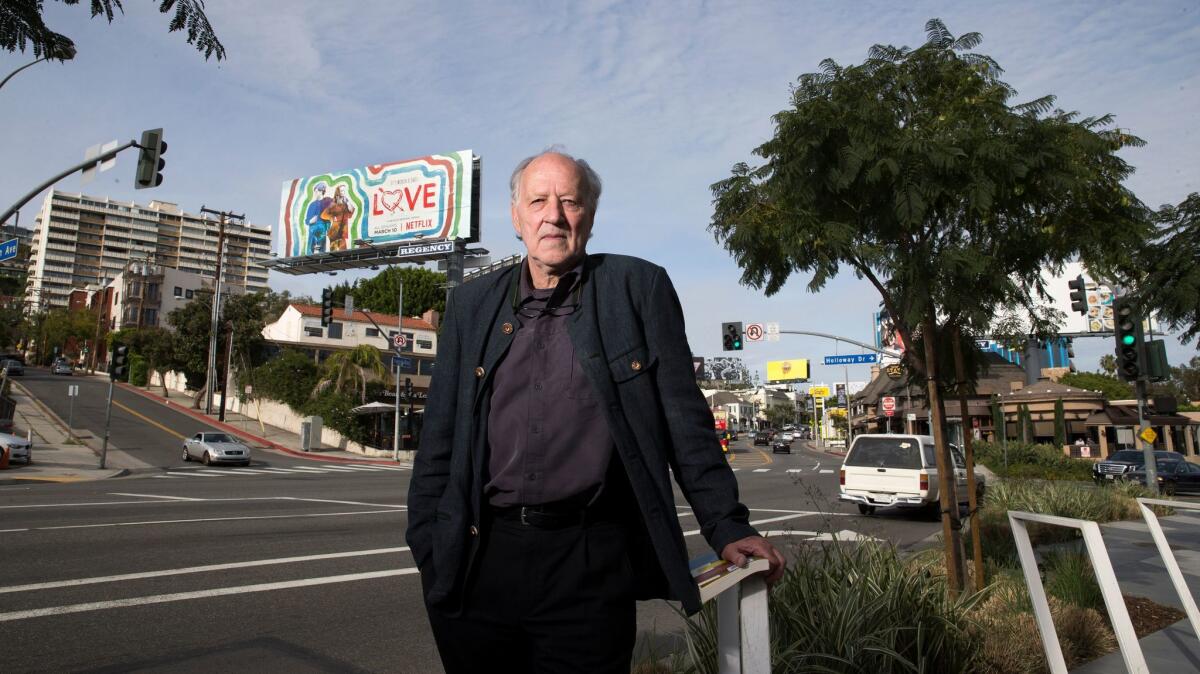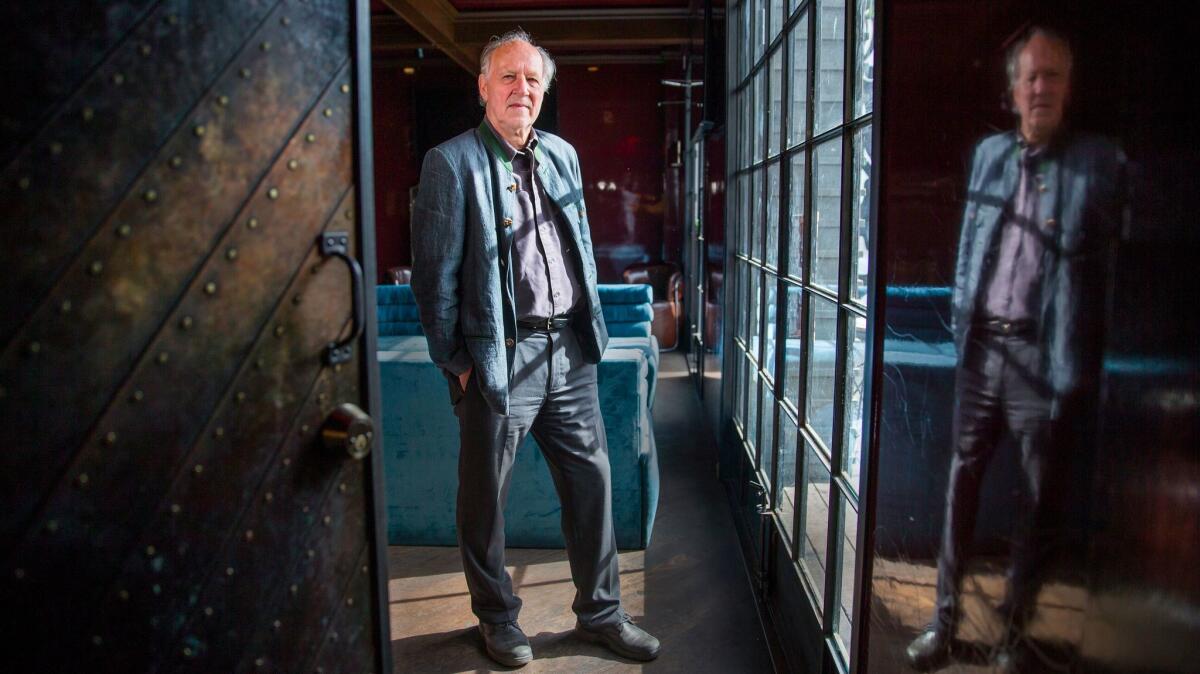Werner Herzog wouldn’t live anyplace other than Los Angeles, ‘the city with the most substance’

Werner Herzog is at a booth in a Sunset Boulevard restaurant, just down the hill from where he once rescued Joaquin Phoenix.
The rescue happened 11 years ago when the freshly Oscar-nominated Phoenix flipped his car on a winding road in Laurel Canyon. The actor, upside down and out of it, reported hearing a gentle tapping on his window, then a voice with a thick accent telling him to relax.
“That’s Werner Herzog!” the actor said to himself. “There’s something so calming and beautiful about Werner Herzog’s voice,” he told reporters afterward.
What Phoenix didn’t say, but Herzog did in the narration he provided for the 2010 animated short “When Herzog Rescued Phoenix” by Sascha Ciezata (of “When Lynch Met Lucas” fame), is that the upside-down Phoenix was trying to light a cigarette while gasoline dripped into the cabin of his car — a Dodge Challenger, if the short is to be believed. Herzog “confiscated” the lighter, smashed in the back window, dragged Phoenix to safety and then dashed off, like a Bavarian Batman driving a Volkswagen Beetle, before the sirens drew too close.
One of the short’s more than 205,000 YouTube viewers commented, “God has the same voice as Werner Herzog … it’s weird.” To which another replied, “God’s real name is Werner, but he’s too shy to admit it.”
On this Friday afternoon of light breezes, mild temperatures and unusual milestones even for a guy with a capacity for milestones, the voice of God is registering slightly apprehensive.
“It’s a little weird,” he says, acknowledging mild anxiety, “because there are two films out on the same day.”

WATCH: Filmmaker Werner Herzog reflects on filmmaking and on living in Los Angeles: “The city has been good to me.” Read the full interview here.
We said we want to move to the city with the most substance, and it was immediately clear that Los Angeles, that’s the place.
— Werner Herzog
The films — “Queen of the Desert,” starring Nicole Kidman, and “Salt and Fire,” starring Michael Shannon, Herzog’s new Klaus Kinski, some might say — are the director’s first narrative offerings in nearly eight years. If you didn’t know any better, you might guess he’d ordered up the combo platter himself to trumpet his return to fiction after his prolific near-decade of making documentaries, including last year’s “Into the Inferno” and “Lo and Behold, Reveries of the Connected World.”
“Oh, for God’s sake, no. I wouldn’t have such a crazy idea. I tried to prevent it, but, uh, my influence has been limited,” the director says, dispelling the notion of an intentional Herzog double feature. “It might happen that the films obliterate each other.… My output is too large. Too big.”
Though we may think concerns about the commercial fates of his films too petty for visionary iconoclasts such as Herzog, he says he’s not one to make art just for art’s sake: “I make them for audiences, always. Not for my own pleasure.”
Though ‘Salt and Fire’ could be taken as a lament, it’s still full of Herzog’s idiosyncratic humor, a characteristic he feels the media often miss.
Not that there isn’t some fun in coming back with a bang, right? “Yes, I try to see the fun inside of it,” he smiles.
Herzog is a fit 74, with eyes that actually twinkle and a traditional Bavarian Trachten jacket carefully placed on the chair next to him for a later photo shoot. Searching for the fun inside the mysteries of life, fate and people’s obsessions would seem to sum up Herzog’s mission, whose arrival as a visionary filmmaker began in 1968 when his first feature film, “Signs of Life,” won a grand jury prize at the Berlin International Film Festival. That search has led him to death row, under Antarctic ice, into ancient caves and up to the mouths of active volcanoes — usually with a sense of play about what he’s doing, even in extreme conditions.
The new films are set in deserts on opposite sides of the world, and though “Salt and Fire” could be taken as a lament, it’s still full of Herzog’s idiosyncratic humor, a characteristic he feels the media often miss.
Take a recent Rolling Stone article. “They [used] a photo where I look as grim as grim, and gloomy and crazed. It’s how the media wants to portray me,” Herzog says, scrunching his face into an impression of the photo. “I think I have a good sense of humor.”

And if the media don’t always get him, Herzog insists his audiences do. “They always laugh. It’s sometimes a strange, dark unusual sense of humor. It’s not the Eddie Murphy humor; it’s something else.”
Herzog says his humor has been buoyed over the past 20 years by his living in Los Angeles, which he turned to after things didn’t work out with San Francisco. “My wife and I found it not the most exciting place in the United States and we said we want to move to the city with the most substance, and it was immediately clear that Los Angeles, that’s the place.”
As for “the glitz and glamour of Hollywood,” Herzog says, “that is a very thin crust. Behind it is an enormous intensity of culture and creative energy and things that ultimately decide the big things, the big internal movements of the planet. Things get done here.”
Among those things: “The collective dreams of the world in cinema and acceptance of gays and lesbians as an integral part of a dignified civilization, and many, many other things that are just wonderful. You see the influx of the Mexicans, which I find very invigorating…. If you can imagine California or Los Angeles without the Mexican population, it would be the instant end of California.”
To Herzog, someone like Elon Musk epitomizes the spirit of Los Angeles, with his outsize ambitions to day-trip private citizens to the moon and eventually colonize Mars.
“The kind of confidence of Elon Musk … you don’t find it anywhere else,” Herzog says. “It has advanced what we’ve done on this planet considerably.
And yet Los Angeles, Herzog admits, has also contributed its fair share to the “big cultural stupidities,” such as hippies (“The worldview was just not adequate to the real problems of the time,” he says), children’s yoga, the choco-nut smoothies on the breakfast menu here and, despite his admiration for Musk, colonizing Mars.
“Mars is an ill-conceived idea. It’s definitely ill-conceived and it’s not going to happen,” Herzog says. “We should look after the habitability of our planet rather than making an inhospitable planet, Mars, somehow livable.”
Herzog, though, might be willing to join Musk on one of his lunar jaunts — provided certain conditions were met.
“Well, I have said it to him, just to get some spark of a reaction out of him, ‘Yes, of course, I’d like to go — only if I had a camera along. Sure, that would be wonderful,’” he says, grinning. “They always send technicians out into space and they haven’t sent a poet out there yet.”
The impulse to send civilians into space does strike a chord with Herzog, who thought the idea to give a seat on the space shuttle Challenger’s doomed 10th mission to schoolteacher Christa McAuliffe was inspired. “My breath and my heart stopped for a moment, because all of a sudden there was some new idea…. Send somebody who would go back to her classroom and have some exciting stories for the kids.”
Back on terra firma, Herzog says he’s always seeing something new and inspiring in Los Angeles. “All the time, all the time,” he says. “There’s never been a dull day here in Los Angeles.”
Oh, for God’s sake, no. I wouldn’t have such a crazy idea. I tried to prevent it.
— Werner Herzog on having two movies out at the same time
Herzog’s first U.S. city, however, was Pittsburgh, when as a 20-year-old student from the Bavarian Alps he studied film at Duquesne University.
“I had worked in a steel factory as a welder during high school to earn money for my first films. So, I thought, that’s the right men out there for me,” he says. “But [the steel industry] was in decay already. It was in full decay and it was clear it would not recover.”
In Pittsburgh, though, and in traveling throughout the Midwest, Herzog says he saw the best of the country. “I was picked up, literally, from the street by a family who gave me shelter when I dropped out of university … I was homeless and I had lost the money of the scholarship — and all of the sudden, enormous hospitality. In all the difficulties I had at the time, Americans of the heartland had been the best of the best.”
Herzog isn’t surprised that the issue of Rust Belt decay has finally found its way to the top of the national conversation. “There’s justice in it,” he says, “because for years, I have been complaining to my friends, liberals, Democrats — men and women who have a lot of sense, make good observations, but they came to politics between Seattle and Boston and New York and Los Angeles and would speak about the rest of America as ‘the flyovers.’ And, I said, ‘That’s a cynic way to look at the heartland of America.’”
Though Herzog thinks “it’s good that the heartland found its voice,” he knows all too well what can happen when that voice curdles. “In my childhood and in my adolescence, I saw the aftermath of what should have never happened. But let me say something about America. America, no matter what, always has this enormous, mysterious way to rejuvenate itself and pull itself out of crisis, and that is something that always gives me confidence in your country.”
It’s reassuring, perhaps, that Herzog, an artist who has mined as deeply as any the absurdities and pratfalls of our existence, is optimistic about the future. “I’m not into the mood of Weltschmerz,” he says, using the German word for world weariness that describes how many are feeling these days. “I’m into the mood of joy of the world, absolute joy and curiosity. I’m full of projects. I’m full of joy and full of things that I see on the horizon.”
-------------
‘Salt and Fire’
Not rated
Running time: 1 hour, 38 minutes
Playing: Through Wednesday, Arena Cinelounge Sunset, Hollywood; also streaming on Amazon and VOD.
-------------
‘Queen of the Desert’
Rated: PG-13, for brief nudity and some thematic elements
Running time: 2 hours, 8 minutes
Playing: AMC Rolling Hills 20; AMC Orange 30
Sign up for our weekly Indie Focus newsletter »

Twitter: @joedjoedonnelly
MORE ABOUT WERNER HERZOG:
The brazen Bavarian Werner Herzog is back with his latest directorial effort, ‘Salt and Fire’
Review: ‘Lo and Behold,’ Werner Herzog terrifies us about the future
Re-release of Werner Herzog’s ‘Nosferatu’: ‘It’s not a remake’
Filmmaker Werner Herzog on his new box set and more
Werner Herzog’s cautionary tale for texters
More to Read
The biggest entertainment stories
Get our big stories about Hollywood, film, television, music, arts, culture and more right in your inbox as soon as they publish.
You may occasionally receive promotional content from the Los Angeles Times.










